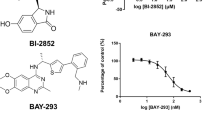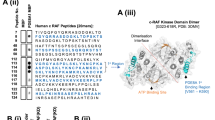Abstract
Cancer is a complex disease involving multiple oncogenes with diverse actions. Inhibiting only one oncogene is unlikely to eliminate the malignancy of cancer cells. The goal of this study was to investigate whether synergistic effects can be achieved by combined silencing of two oncogenes, K-ras and Akt2, which are key players in the Ras/MAPK and PI3K/Akt signaling pathways. The pancreatic cancer cell line, Panc-1, was selected for these studies as it has elevated expression of K-ras and Akt2. Compared with inhibiting each oncogene alone, simultaneously silencing the two oncogenes with RNA interference (RNAi) more effectively inhibited Panc-1 cell proliferation and colony formation, induced a significantly higher percentage of apoptosis and resulted in greater inhibition of c-myc expression in vitro. Furthermore, when delivered by polyethyleneimine into Panc-1 tumors in nude mice, RNAi simultaneously targeting K-ras and Akt2 inhibited tumor growth more efficiently than RNAi targeting the individual oncogenes. Therefore, RNAi simultaneously silencing the oncogenes K-ras and Akt2 may offer potential opportunities for pancreatic cancer gene therapy.
This is a preview of subscription content, access via your institution
Access options
Subscribe to this journal
Receive 12 print issues and online access
$259.00 per year
only $21.58 per issue
Buy this article
- Purchase on Springer Link
- Instant access to full article PDF
Prices may be subject to local taxes which are calculated during checkout





Similar content being viewed by others
References
Hanahan D, Weinberg RA . The hallmarks of cancer. Cell 2000; 100: 57–70.
Greenlee RT, Hill-Harmon MB, Murray T, Thun M . Cancer statistics. CA Cancer J Clin 2001; 51: 15–36.
Neoptolemos JP, Stocken DD, Friess H, Bassi C, Dunn JA, Hickey H et al. A randomized trial of chemoradiotherapy and chemotherapy after resection of pancreatic cancer. N Engl J Med 2004; 350: 1200–1210.
Li D, Xie K, Wolff R, Abbruzzese JL . Pancreatic cancer. Lancet 2004; 363: 1049–1057.
Talar-Wojnarowska R, Malecka-Panas E . Molecular pathogenesis of pancreatic adenocarcinoma: potential clinical implications. Med Sci Monit 2006; 12: 186–193.
Yoshida T, Ohnami S, Aoki K . Development of gene therapy to target pancreatic cancer. Cancer Sci 2004; 95: 283–289.
Saad ED, Hoff PM . Molecular-targeted agents in pancreatic cancer. Cancer Control 2004; 11: 32–38.
Lim K, Christopher M . Reduction in the requirement of oncogenic Ras signaling to activation of PI3K/AKT pathway during tumor maintenance. Cancer cell 2005; 8: 381–392.
Michl P, Downward J . Mechanisms of disease: PI3K/AKT signaling in gastrointestinal cancers. Z Gastroenterol 2005; 43: 1133–1139.
Ruggeri BA, Huang L, Wood M, Cheng JQ, Testa JR . Amplification and overexpression of the AKT2 oncogene in a subset of human pancreatic ductal adenocarcinomas. Mol Carcinog 1998; 21: 81–86.
Chen J, Liu TH, Guo XY, Ye SF . Two new human exocrine pancreatic adenocarcinoma cell lines in vitro and in vivo. Chin Med J (Engl) 1990; 103: 369–375.
Arens N, Gandhari M, Bleyl U, Hildenbrand R . In vitro suppression of urokinase plasminogen activator in breast cancer cells—a comparison of two antisense strategies. Int J Oncol 2005; 26: 113–119.
D'Alessio S, Margheri F, Pucci M, Del Rosso A, Monia BP, Bologna M et al. Antisense oligodeoxynucleotides for urokinase-plasminogen activator receptor have anti-invasive and anti-proliferative effects in vitro and inhibit spontaneous metastases of human melanoma in mice. Int J Cancer 2004; 110: 125–133.
Yang L, Dan HC . Akt/protein kinase b signaling inhibitor-2, a selective small molecule inhibitor of Akt signaling with antitumor activity in cancer cells overexpressing Akt. Cancer Res 2004; 64: 4394–4399.
Cheng JH, Ruggerit B . Amplification of AKT2 in human pancreatic cancer cells and inhibition of AKT2 expression and tumorigenicity by antisense RNA. Proc Natl Acad Sci USA 1996; 93: 3636–3641.
Cohen SJ, Ho L, Ranganathan S, Abbruzzese JL, Alpaugh RK, Beard M et al. Phase II and pharmacodynamic study of the farnesyltransferase inhibitor R115777 as initial therapy inpatients with metastatic pancreatic adenocarcinoma. J Clin Oncol 2003; 21: 1301–1306.
Vignot S, Faivre S . mTOR-targeted therapy of cancer with rapamycin derivatives. Ann Oncol 2005; 16: 525–537.
Schweinitz A, Steinmetzer T, Banke IJ, Arlt MJ, Stürzebecher A, Schuster O et al. Design of novel and selective inhibitors of urokinase-type plasminogen activator with improved pharmacokinetic properties for use as antimetastatic agents. J Biol Chem 2004; 279: 33613–33622.
D'Alessio S, Margheri F, Pucci M, Del Rosso A, Monia BP, Bologna M et al. Antisense oligodeoxynucleotides for urokinase-plasminogen activator receptor have anti-invasive and anti-proliferative effects in vitro and inhibit spontaneous metastases of human melanoma in mice. Int J Cancer 2004; 110: 125–133.
Lin Z, Nuo Y . Vector-based RNAi, a novel tool for isoform-specific knock-down of VEGF and anti-angiogenesis gene therapy of cancer. Biochem Biophys Res Commun 2003; 30: 1169–1178.
Kaiyi L, Shiaw FB . Use of RNA interference to target cyclin E-overexpressing hepatocellular carcinoma. Cancer Res 2003; 63: 3593–3597.
Bondar VM, Sweeney-Gotsch B, Andreeff M, Mills GB, McConkey DJ . Inhibition of the phosphatidylinositol 3′-kinase-AKT pathway induces apoptosis in pancreatic carcinoma cells in vitro and in vivo. Mol Cancer Ther 2002; 1: 989–997.
Friess H, Kleeff J, Korc M, Büchler MW . Molecular aspects of pancreatic cancer and future perspectives. Dig Surg 1999; 16: 281–290.
Reddy SA . Signaling pathways in pancreatic cancer. Cancer J 2001; 7: 274–286.
Asano T, Yao Y, Zhu J, Li D, Abbruzzese JL, Reddy SA . The PI 3-kinase/Akt signaling pathway is activated due to aberrant Pten expression and targets transcription factors NF-kappaB and c-Myc in pancreatic cancer cells. Oncogene 2004; 23: 8571–8580.
Maira SM, Galetic I, Brazil DP, Kaech S, Ingley E, Thelen M et al. Carboxyl-terminal modulator protein (CTMP), a negative regulator of PKB/Akt and v-Akt at the plasma membrane. Science 2001; 294: 374–380.
Peneul E, Martin GS . Tranformation by V-src: Ras-MAPK and PI3K-mTOR mediated parallel pathways. Mol Biol Cell 1999; 10: 1693–1703.
Edwards LA, Verreault M, Thiessen B, Dragowska WH, Hu Y, Yeung JH et al. Combined inhibition of the phosphatidylinositol 3-kinase/Akt and Ras/mitogen-activated protein kinase pathways results in synergistic effects in glioblastoma cells. Mol Cancer Ther 2006; 5: 645–654.
Yang E, Zha J, Jockel J, Boise LH, Thompson CB, Korsmeyer SJ . Bad, a heterodimeric partner for Bcl-XL and Bcl-2, displaces Bax and promotes cell death. Cell 1995; 80: 285–291.
Bonni A, Brunet A, West AE, Datta SR, Takasu MA, Greenberg ME . Cell survival promoted by the Ras-MAPK signaling pathway by transcription-dependent and independent mechanisms. Science 1999; 286: 1358–1362.
Zha J, Harada H, Yang E, Jockel J, Korsmeyer SJ . Serine phosphorylation of death agonist BAD in response to survival factor results in binding to 14-3-3 not BCL-X(L). Cell 1996; 87: 619–628.
Datta SR, Dudek H, Tao X, Masters S, Fu H, Gotoh Y et al. Akt phosphorylation of BAD couples survival signals to the cell-intrinsic death machinery. Cell 1997; 91: 231–241.
She Q, Solit D . The BAD protein integrates survival signaling by EGFR/MAPK and PI3K/Akt kinase pathways in PTEN-deficient tumor cells. Cancer Cell 2005; 10: 287–297.
Steiner P, Rudolph B, Müller D, Eilers M . The functions of Myc in cell cycle progression and apoptosis. Prog Cell Cycle Res 1996; 2: 73–82.
Nagy A, Kozma L, Kiss I, Ember I, Takacs I, Hajdu J et al. Copy number of cancer genes predict tumor grade and survival of pancreatic cancer patients. Anticancer Res 2001; 21: 1321–1325.
Schleger C, Verbeke C, Hildenbrand R, Zentgraf H, Bleyl U . c-MYC activation in primary and metastatic ductal adenocarcinoma of the pancreas: incidence, mechanisms, and clinical significance. Mod Pathol 2002; 15: 462–469.
Henriksson M, Bakardjiev A, Klein G, Lüscher B . Phosphorylation sites mapping in the N-terminal domain of c-myc modulate its transforming potential. Oncogene 1993; 8: 3199–3209.
Gregory MA, Qi Y, Hann SR . Phosphorylation by glycogen synthase kinase-3 controls c-myc proteolysis and subnuclear localization. J Biol Chem 2003; 278: 51606–51612.
Sears RC . The life cycle of C-myc: from synthesis to degradation. Cell Cycle 2004; 3: 1133–1137.
Sears R, Nuckolls F, Haura E, Taya Y, Tamai K, Nevins JR . Multiple Ras-dependent phosphorylation pathways regulate Myc protein stability. Genes Dev 2000; 14: 2501–2514.
Fabbrini MS, Carpani D, Bello-Rivero I, Soria MR . The amino-terminal fragment of human urokinase directs a recombinant chimeric toxin to target cells: internalization is toxin mediated. FASEB J 1997; 11: 1169–1176.
Author information
Authors and Affiliations
Corresponding author
Rights and permissions
About this article
Cite this article
Shi, X., Liang, Z., Ren, X. et al. Combined silencing of K-ras and Akt2 oncogenes achieves synergistic effects in inhibiting pancreatic cancer cell growth in vitro and in vivo. Cancer Gene Ther 16, 227–236 (2009). https://doi.org/10.1038/cgt.2008.82
Received:
Revised:
Accepted:
Published:
Issue Date:
DOI: https://doi.org/10.1038/cgt.2008.82



